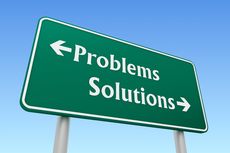
Big Change Ahead
 Stage 1: Do we have a problem?
Stage 1: Do we have a problem?
You´ve probably heard the saying "Dont´t change a winning team" and "If it ain´t broken, don´t fix it", and I would say that this is mostly true. Of course, there is some merit to embracing a culture of change. Having a culture that absorbs and adapts has intrinsic value. However, you should strive to change for a purpose. And trust me, there are seldom a deficiency in good reasons for change. If you have problems reaching your goals, it might be an indicator that you´re ambitious and healthy - unless you habitually miss all your goals, of course. If you consistently reach all your goals, I can say for sure that your goals are not set high enough.
The first step in assessing organizational change is to define where you are missing the mark. The key is to discover the brutal truth. Where do you want to go? Where have you ended up? How far apart is your reality from your requirements? Try to base this on facts and outside input more than your own gut feeling and praise from your peers.
 Stage 2: Is it a serious problem?
Stage 2: Is it a serious problem?
Don´t spend too much time on insignificant stuff. Focus on what really matters. Just because someone in your organization have identified issues or have concerns, you as a leader need to assess if this problem possess a serious threat to your overall vision, goals or values. Fight and conquer the giants. There are two kinds of giants; the issues that really pose a threat to your organization´s very future, or the giants that would lead your organiazation clearly towards its vision.
 Stage 3: Is it our problem?
Stage 3: Is it our problem?
It is often more convenient to fix everybody else´s problems instead of taking an honest hard look at yourself. Are you responsible for the mess? Is the problem within your scope? Should your organization do something about it? Or should you activate others or hold someone else accountable to rectifying the matter?
 Stage 4: Does a solution exist?
Stage 4: Does a solution exist?
Is it possible to solve the problem? This might seem trivial, but is the problem clearly defined? If you had a solution, would it be clear to everyone that it did indeed solve the problem at hand? Be open to failure and hold several options open. As a leader you are responsible for the mess that you´re in, so be humble to accept that you don´t know it all, and accept that you might need to hold unconventional doors open.
 Stage 5: Are we able to solve it?
Stage 5: Are we able to solve it?
Does your organization have the necessary resources to save the day? If not, are you able to either get those resources, or align with someone who possesses those resources? Or maybe you need to refocus your organization taking into account that circumstances outside of your control have altered the game. If you discover that you´re fighting against a trend, more often than not, you will find that the trend wins. Don´t bite off more than you can chew, but remember that even elephants can be digested one bite at a time. See if the solution can be divided up into bite size chunks, and constantly assess your progress.
And remember that a great idea poorly executed is less likely to succeed compared to a mediocre idea executed with excellence. To learn more about how to execute change with flair, please read Kotter´s 8-step change model.











